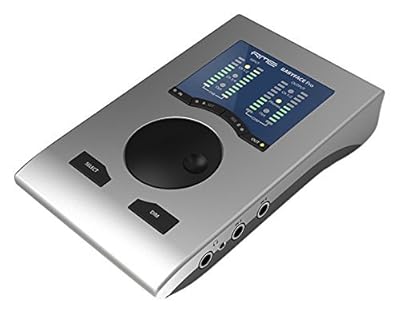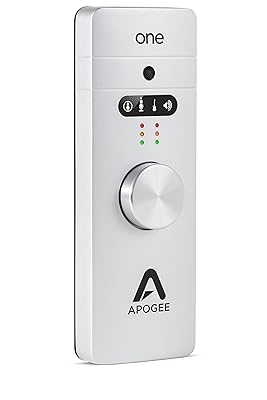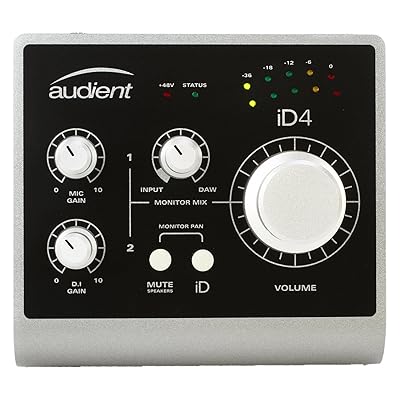The Apollo Twin MKII Solo by Universal Audio can be accurately described as the creme-de-la-creme of audio interfaces when it comes to the quality of its components and its overall build. The unit provides 2 XLR/TRS combination inputs, an optical input, as well as 4 line outputs, making it decent for musicians who only need a few inputs for simultaneous recording.
Now, the main selling point of this audio interface lies in the unit’s internal circuitry and the connectivity type (being thunderbolt), which mean that it can provide sub-2ms round-trip latency, which is extremely low! The audio interface comes with a Universal Audio Plugin Bundle, which includes: Legacy versions of the LA-2A, 1176LN, Pultec EQP-1A, plus Softube Amp Room Essentials, Raw Distortion, 610-B Tube Preamp & EQ, and more
Additionally, the interface has some other useful features, such as a built-in talkback microphone, which is ideal for a professional studio environment.
The Apollo Twin is an EDM industry favorite. In fact, in a recent NGHTMRE Snapchat he can be seen using this great interface while teasing one of his newest releases. With a sturdy build and unique look, the Apollo Twin is also an excellent interface with the tone feel and flow of an analog controller. This interface differs from most of the others that we have covered as it requires a Thunderbolt connection to be used with your computer. If you’re looking for an industry leading interface for a professional sound, look no further than the Apollo Twin.
A scaled-down alternative to Universal Audio’s flagship Apollo 8 and 16, the original Apollo Twin has been giving ‘the rest of us’ access to those mythical Unison preamps, first-class I/O and swanky UAD plugins for three years now.
The new Apollo Twin MkII is essentially more of the same, but with a few minor improvements, and an optional DSP upgrade. Let’s start with what’s stayed the same.
The top panel centers on a satisfyingly oversized knob, controlling Monitor or Preamp input levels, as selected with the two buttons flanking it; and six Option buttons, contextualised by an LED icon strip, that again change function depending on whether the unit is in Monitor or Preamp mode. Input and output metering are provided by four five-segment LED ladders.
The back panel and front edge house two combi Mic/Line inputs. It also has a Hi-Z quarter-inch guitar input (overriding Mic/Line 1 when occupied), four quarter-inch output jacks (two Monitor, two Line). Not forgetting the stereo S/PDIF out, Headphones out and a TOSLINK port. This last port is for adding up to eight analogue inputs via ADAT.
Still a desktop-format 2-in/-6-out interface with 24-bit/192kHz capabilities, the Apollo Twin MkII would be almost indistinguishable from the original were it not now black rather than silver. It connects to your Mac or PC via Thunderbolt, but it has to be powered from the wall; and while the original Twin (still available) could be had in a USB 3 version, it’s not clear whether the MkII will follow suit.
Also a ‘DSP box’ for powering UAD plugin effects (VST/AU/AAX/RTAS), the Apollo Twin MkII features the same game-changing Unison preamps as its predecessor, fed by the Mic/Line and Hi-Z ins. These enable a gradually expanding subset of UA’s classic hardware emulation plugins to be inserted directly into each input path. Physically reconfiguring the preamp’s impedance and gain staging. As an alternative to the regular algorithmic modeling of valves, transistors, amps, EQ. This results in near-zero-latency monitoring and/or recording through them.
When we first reviewed the Twin, there were only three Unison plugins available – the UA 610-B (bundled), the UA 610-A and the API Vision. Since then, they’ve been joined by the Manley Voxbox, Neve 1073 and 88RS; eight guitar and bass amps by Ampeg, Fender and Marshall; and three distortion stompboxes, including the bundled Pro Co Rat emulation, Raw. All of them sound and feel great, and Unison remains a huge and unique selling point for the Apollo Twin MkII.
So, apart from the color change, what else is new? Well, UA has apparently beefed up the AD/DA converters, for even more dynamic range and less distortion, but the MkI was so outstanding in this department that you’ll be hard pushed to tell the difference – it’s still the cleanest, most transparent-sounding interface in its price range.
Other than that, the MkII sees a refinement of its studio workflow with the addition of a talkback mic and front panel access to a few of the monitoring functions of the Console software (see It’s not just the hardware).
The Talk button activates the talkback mic (the tiny hole below the knob), which can be sent to the outputs of your choice for control room communication or quick recording of notes and cues. The Dim button lowers the monitor output level, the Mute switch kills it entirely, and the Mono button switches between stereo and mono output for playback system compatibility checking. Very nice.
In Monitor mode, four of the Option buttons – which weren’t used at all by MkI – now come into play, necessitating the addition of a new row of icons to the LED strip, which has been made a bit deeper to accommodate them.
Apollo’s creed Apart from the Quad Core option, the Apollo Twin MkII is the very definition of an iterative upgrade. If you’re already a happy owner of MkI, the talkback mic and extra monitoring control alone aren’t reasons enough to reinvest. If, however, you’ve been hankering for more DSP than your existing Twin affords you, your day has come – have at it. And, of course, newcomers to the world of Apollo and UAD now get even more for their money, which can only be a good thing.
Given how much we loved the original Apollo Twin, it’ll come as no surprise that the MkII again wins our highest possible recommendation. Far more than possibly the best audio interface ever made. This is a musically empowering hardware/software hybrid. Capable of elevating even the humblest of home and project studios to genuinely professional-quality heights.
Compatibility
- Mac & PC
- Supports all major DAWs
Features
- 2 x 6 audio interface
- Highly reputable brand
- Rather compact, metal chassis
- Near to zero-latency (2ms according to reports)
- SHARC DSP for running UAD plug-ins without burdening the computer CPU
- Unison technology providers classic tube and transformer-based preamp models
- Talkback microphone
- Warranty: 1-Year Manufacturers Warranty
Technical Specs
- Thunderbolt connectivity
- 2-in / 6-out
- 2 XLR/TRS combination inputs
- Optical In
- 4 line outputs
- Powered by a 12v power supply
- 24-bit/96kHz resolution
- 48v Phantom power
Pros
- Ultra high-quality audio interface
- Rather portable
- Handles processing, instead of overworking your PC/Mac
- Built-in talkback microphone
- Less than 2ms round-trip latency
- Comes with full UAD plug-in bundle
- 1-year manufacturers warranty








